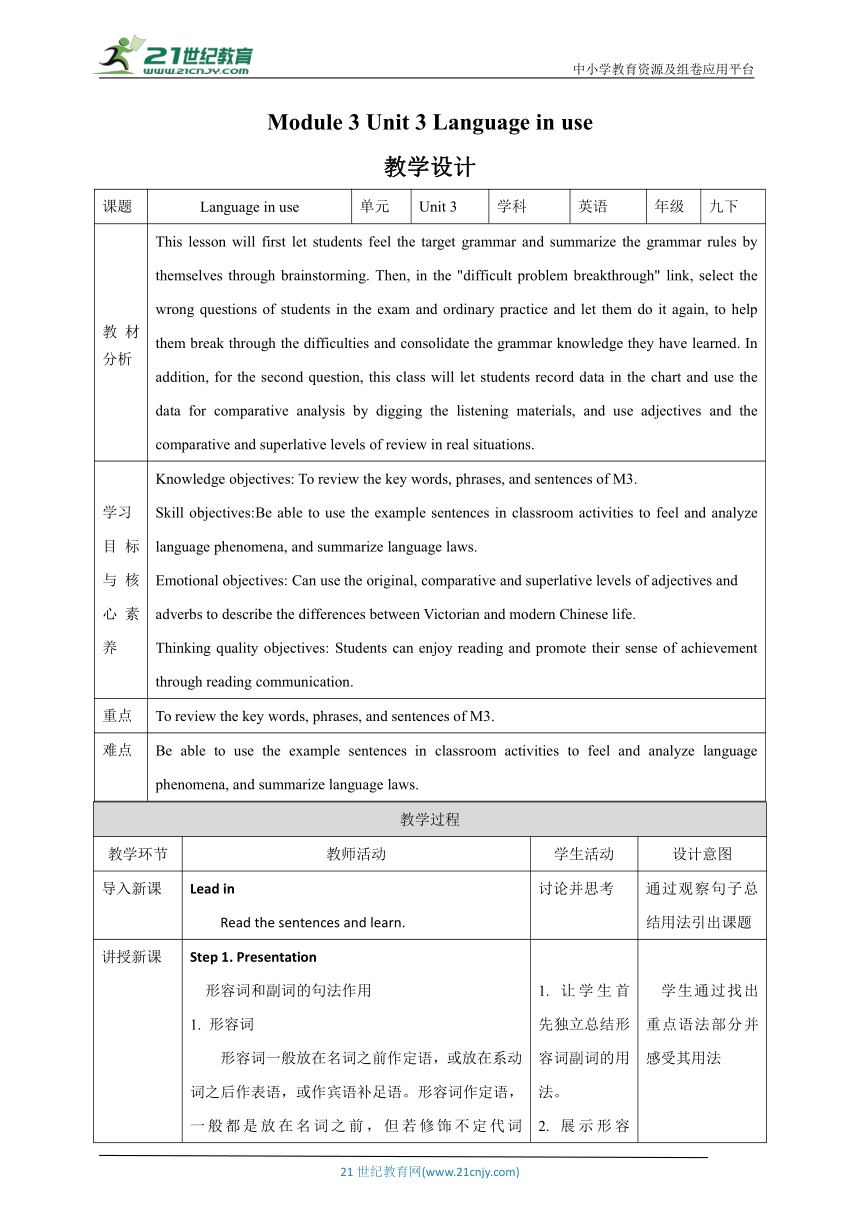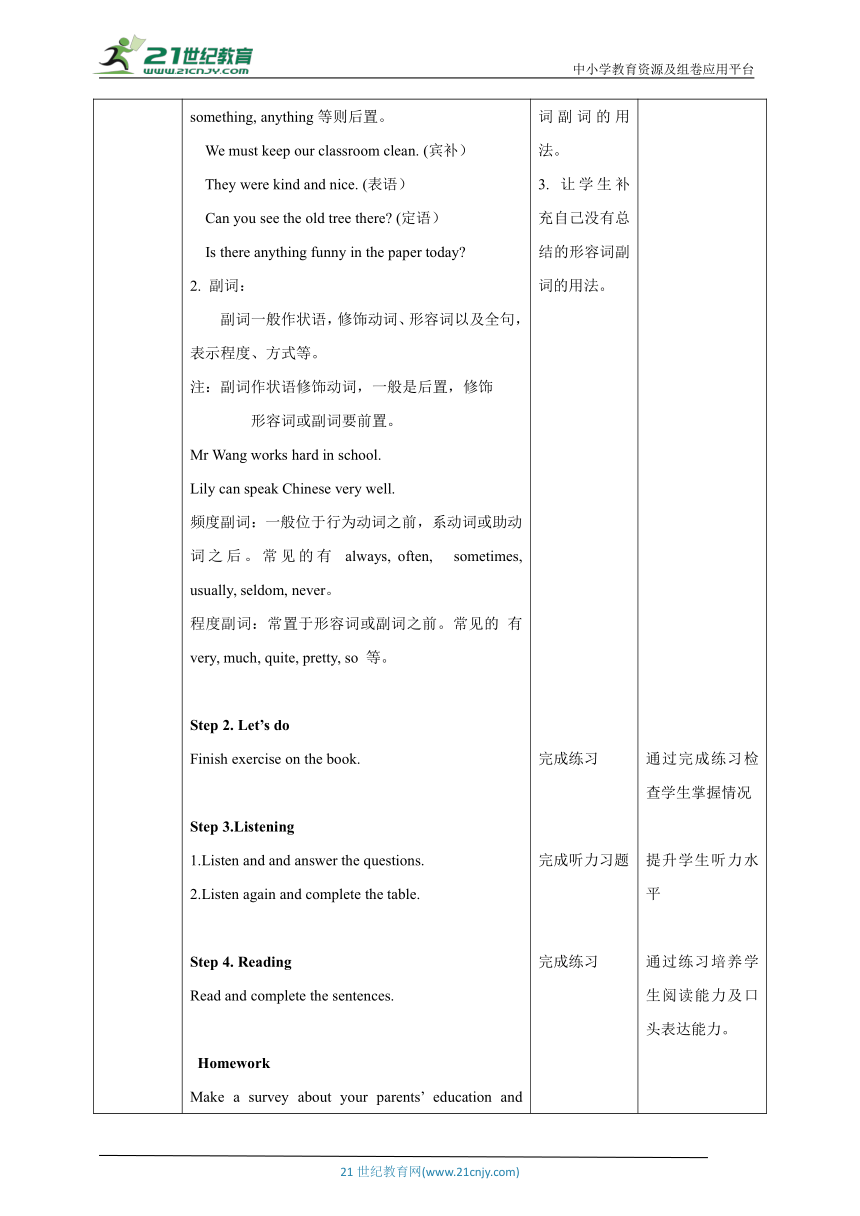(核心素养目标)Module 3 Life now and then Unit 3 Language in use表格式教学设计
文档属性
| 名称 | (核心素养目标)Module 3 Life now and then Unit 3 Language in use表格式教学设计 |

|
|
| 格式 | doc | ||
| 文件大小 | 1.2MB | ||
| 资源类型 | 试卷 | ||
| 版本资源 | 外研版 | ||
| 科目 | 英语 | ||
| 更新时间 | 2023-02-23 15:28:29 | ||
图片预览


文档简介
中小学教育资源及组卷应用平台
Module 3 Unit 3 Language in use
教学设计
课题 Language in use 单元 Unit 3 学科 英语 年级 九下
教材分析 This lesson will first let students feel the target grammar and summarize the grammar rules by themselves through brainstorming. Then, in the "difficult problem breakthrough" link, select the wrong questions of students in the exam and ordinary practice and let them do it again, to help them break through the difficulties and consolidate the grammar knowledge they have learned. In addition, for the second question, this class will let students record data in the chart and use the data for comparative analysis by digging the listening materials, and use adjectives and the comparative and superlative levels of review in real situations.
学习目标与核心素养 Knowledge objectives: To review the key words, phrases, and sentences of M3.Skill objectives:Be able to use the example sentences in classroom activities to feel and analyze language phenomena, and summarize language laws.Emotional objectives: Can use the original, comparative and superlative levels of adjectives and adverbs to describe the differences between Victorian and modern Chinese life.Thinking quality objectives: Students can enjoy reading and promote their sense of achievement through reading communication.
重点 To review the key words, phrases, and sentences of M3.
难点 Be able to use the example sentences in classroom activities to feel and analyze language phenomena, and summarize language laws.
教学过程
教学环节 教师活动 学生活动 设计意图
导入新课 Lead inRead the sentences and learn. 讨论并思考 通过观察句子总结用法引出课题
讲授新课 Step 1. Presentation 形容词和副词的句法作用1. 形容词 形容词一般放在名词之前作定语,或放在系动词之后作表语,或作宾语补足语。形容词作定语,一般都是放在名词之前,但若修饰不定代词 something, anything等则后置。 We must keep our classroom clean. (宾补) They were kind and nice. (表语) Can you see the old tree there (定语) Is there anything funny in the paper today 2. 副词: 副词一般作状语,修饰动词、形容词以及全句,表示程度、方式等。注:副词作状语修饰动词,一般是后置,修饰 形容词或副词要前置。Mr Wang works hard in school.Lily can speak Chinese very well.频度副词:一般位于行为动词之前,系动词或助动词之后。常见的有 always, often, sometimes, usually, seldom, never。程度副词:常置于形容词或副词之前。常见的 有very, much, quite, pretty, so 等。Step 2. Let’s doFinish exercise on the book.Step 3.Listening1.Listen and and answer the questions.2.Listen again and complete the table. Step 4. ReadingRead and complete the sentences. HomeworkMake a survey about your parents’ education and write down your opinion. 1. 让学生首先独立总结形容词副词的用法。2. 展示形容词副词的用法。3. 让学生补充自己没有总结的形容词副词的用法。完成练习完成听力习题完成练习 学生通过找出重点语法部分并感受其用法通过完成练习检查学生掌握情况提升学生听力水平通过练习培养学生阅读能力及口头表达能力。
课堂练习 单选用所给词的适当形式填空
课堂小结 ask sb for helpbe interested in doing sth.find outinstead of thousands of be close toas a result in accidents ofwrite to sb
板书 Module 3 Unit 3 Language in use ask sb for helpbe interested in doing sth.find outinstead of thousands of be close toas a result in accidents ofwrite to sb
21世纪教育网 www.21cnjy.com 精品试卷·第 2 页 (共 2 页)
HYPERLINK "http://www.21cnjy.com/" 21世纪教育网(www.21cnjy.com)
Module 3 Unit 3 Language in use
教学设计
课题 Language in use 单元 Unit 3 学科 英语 年级 九下
教材分析 This lesson will first let students feel the target grammar and summarize the grammar rules by themselves through brainstorming. Then, in the "difficult problem breakthrough" link, select the wrong questions of students in the exam and ordinary practice and let them do it again, to help them break through the difficulties and consolidate the grammar knowledge they have learned. In addition, for the second question, this class will let students record data in the chart and use the data for comparative analysis by digging the listening materials, and use adjectives and the comparative and superlative levels of review in real situations.
学习目标与核心素养 Knowledge objectives: To review the key words, phrases, and sentences of M3.Skill objectives:Be able to use the example sentences in classroom activities to feel and analyze language phenomena, and summarize language laws.Emotional objectives: Can use the original, comparative and superlative levels of adjectives and adverbs to describe the differences between Victorian and modern Chinese life.Thinking quality objectives: Students can enjoy reading and promote their sense of achievement through reading communication.
重点 To review the key words, phrases, and sentences of M3.
难点 Be able to use the example sentences in classroom activities to feel and analyze language phenomena, and summarize language laws.
教学过程
教学环节 教师活动 学生活动 设计意图
导入新课 Lead inRead the sentences and learn. 讨论并思考 通过观察句子总结用法引出课题
讲授新课 Step 1. Presentation 形容词和副词的句法作用1. 形容词 形容词一般放在名词之前作定语,或放在系动词之后作表语,或作宾语补足语。形容词作定语,一般都是放在名词之前,但若修饰不定代词 something, anything等则后置。 We must keep our classroom clean. (宾补) They were kind and nice. (表语) Can you see the old tree there (定语) Is there anything funny in the paper today 2. 副词: 副词一般作状语,修饰动词、形容词以及全句,表示程度、方式等。注:副词作状语修饰动词,一般是后置,修饰 形容词或副词要前置。Mr Wang works hard in school.Lily can speak Chinese very well.频度副词:一般位于行为动词之前,系动词或助动词之后。常见的有 always, often, sometimes, usually, seldom, never。程度副词:常置于形容词或副词之前。常见的 有very, much, quite, pretty, so 等。Step 2. Let’s doFinish exercise on the book.Step 3.Listening1.Listen and and answer the questions.2.Listen again and complete the table. Step 4. ReadingRead and complete the sentences. HomeworkMake a survey about your parents’ education and write down your opinion. 1. 让学生首先独立总结形容词副词的用法。2. 展示形容词副词的用法。3. 让学生补充自己没有总结的形容词副词的用法。完成练习完成听力习题完成练习 学生通过找出重点语法部分并感受其用法通过完成练习检查学生掌握情况提升学生听力水平通过练习培养学生阅读能力及口头表达能力。
课堂练习 单选用所给词的适当形式填空
课堂小结 ask sb for helpbe interested in doing sth.find outinstead of thousands of be close toas a result in accidents ofwrite to sb
板书 Module 3 Unit 3 Language in use ask sb for helpbe interested in doing sth.find outinstead of thousands of be close toas a result in accidents ofwrite to sb
21世纪教育网 www.21cnjy.com 精品试卷·第 2 页 (共 2 页)
HYPERLINK "http://www.21cnjy.com/" 21世纪教育网(www.21cnjy.com)
同课章节目录
- Module 1 Travel
- Unit 1 We toured the city by bus and by taxi
- Unit 2 It's a long story.
- Unit 3 Language in use
- Module 2 Education
- Unit 1 They don't sit in rows.
- Unit 2 What do I like best about school?
- Unit 3 Language in use
- Module 3 Life now and then
- Unit 1 They sometimes work harder.
- Unit 2 I think life is better today.
- Unit 3 Language in use.
- Module 4 Rules and suggestions
- Unit 1 You must be careful of falling stones.
- Unit 2 we must keep the camp clean.
- Unit 3 Language in use.
- Revison A
- Module 5 Look after yourself
- Unit 1 We'd better get you to hospital.
- Unit 2 Get off the sofa!
- Unit 3 Language in use.
- Module 6 Eating togethe
- Unit 1 When is the school-leavers' party?
- Unit 2 Knives and forks are used for most Western
- Unit 3 Language in use
- Module 7 English for you and me
- Unit 1 Have you ever been to an English corner?
- Unit 2 We all own English.
- Unit 3 Language in use
- Module 8 My future life
- Unit 1 Here's to our friendship and the future
- Unit 2 I know that you will be better at maths.
- Unit 3 Language in use
- Revison B
